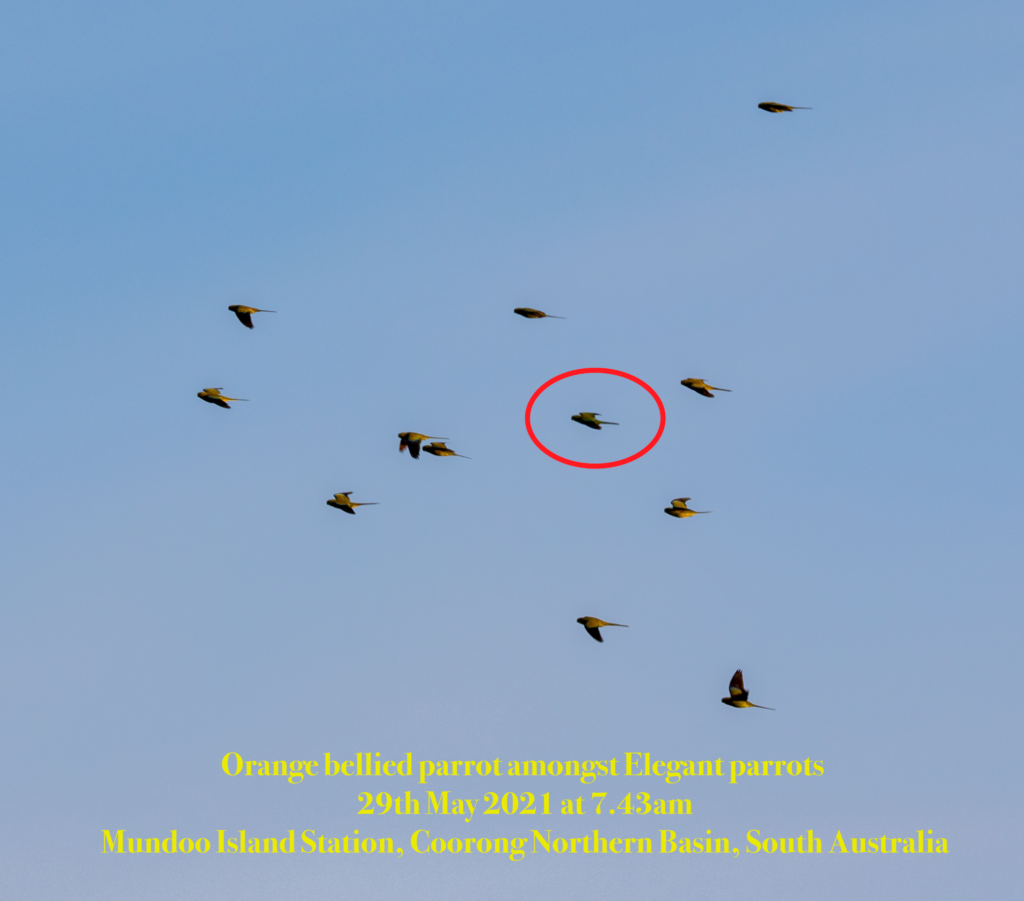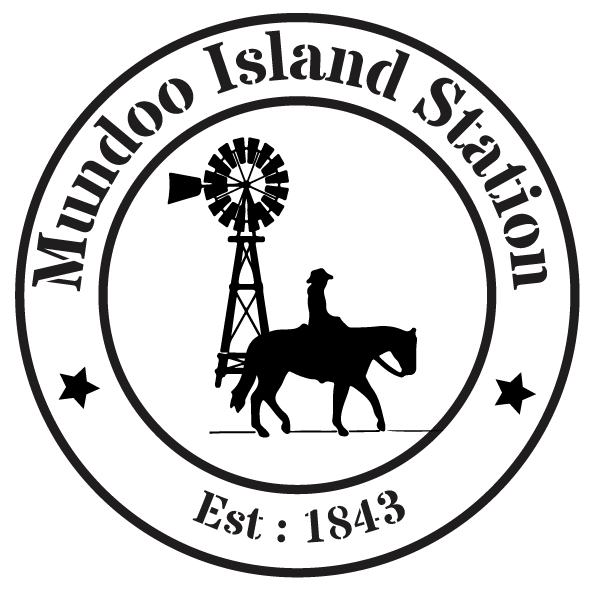Exciting News … I photographed an Orange-bellied parrot (Critically endangered species) on Mundoo Island Station on Saturday morning and 1 was photographed and another heard on Hindmarsh Island by Bob Green (SA Orange-bellied parrot Regional Coordinator) on Saturday afternoon. This is such exciting news for these amazing birds.
There are four Coastal Neophema Parrots (Orange-bellied, Blue-winged, Elegant and Rock Parrot)and now I have photographed all 4 on Mundoo Island Station.
I have conducted the winter OBP surveys on our property for many years with the assistance of Michelle. All with the hope that one day we would again see one in the Coorong’s northern lagoon. The last recorded sighting on our property was in 2010 and the most recent was at Cantara in the southern basin of the Coorong in 2013. Maybe the recording of these OBPs last Saturday is an indication that things are looking up for this species.
This is the first year we have recorded such large numbers of Elegant parrots and more than usual numbers of Blue-winged parrots. They are literally in their hundreds at the moment.
In 2013/14 we undertook a huge revegetation effort on the coastal fringes of our paddocks. Planting 140,000 trees, shrubs and grasses as well as excluding livestock from the areas. It seems that this has provided safe roosting areas for neophemas and a plentiful food source. If we can sort some more funding, we can plant more shrubs in these areas to ensure a continued haven for birds as the tress die over the years.
Thanks to Bob Green for his continued assistance with our Neophema surveys and ID questions.
The following information is from the Birdlife Australia website:
The Orange-bellied Parrot breeds only in the South West of Tasmania. After breeding has concluded, most of the population migrates across Bass Strait to spend the winter months on southern mainland Australia. The adults leave a few weeks before the juvenile birds. On the mainland they often associate with other small ‘grass parrots’ with which they are often confused, but are best distinguished by their bright plumage and distinctive buzzing alarm calls. They return to the breeding grounds in spring, with adults arriving a few weeks before the juveniles.
Description
The Orange-bellied Parrot is just bigger than a Budgerigar, with males and females varying slightly in appearance. The male is a bright grass-green on the head, back and most of the wings, fading to a yellowish-green on throat and breast, to bright yellow to the vent and under the tail. The belly has a bright orange patch, and there is a deep blue band between the eyes, bordered above by a faint blue line. The male also has bright blue on the bend of the wings. The female is duller, with less blue and has a smaller orange belly patch. Both male and females have a greyish-black bill, a dark-brown eye and greyish-brown legs.
Similar Species
There are three closely-related species similar to the Orange-bellied Parrot: the Blue-winged Parrot, N. chrysostoma, the Rock Parrot , N. petrophila and the Elegant Parrot, N. elegans. All have similar colourings, are similar in size and some of them can even have an orange belly, so care must be taken in distinguishing these four species.
Distribution
Orange-bellied Parrots breed in Tasmania then migrate to the southern coast of mainland Australia, as far west as Yorke Penisula in South Australia, and east in Victoria to Westernport Bay. Occasionally the Orange-bellied Parrot is seen out of this range, including a sighting in Sydney in 2004.
Habitat
Orange-bellied Parrots are seen almost exclusively in coastal and sub-coastal areas, preferring peninsulas and islands. Saltmarshes, littoral (shore) heathlands and low scrublands are preferred habitats as well as grassy areas, which can include golf courses. They breed in forests on the west coast of Tasmania dominated by Smithton Peppermints, Eucalyptus nitida, but tend to avoid extensive tracts of temperate rainforest.
Feeding
The Orange-bellied Parrot feeds on the ground or on low-growing shrubs, with food consisting of seeds, fruits, flowers and berries of sedges, herbaceous plants and plants that grow in salty or alkaline conditions such as saltmarshes.
Breeding
The Orange-bellied Parrot nests in tree-hollows, both knot-holes in trunks and holes in dead branches, but usually not in stags (dead trees). The female cleans out the nest hollow then lays the eggs about two days apart. She incubates the eggs and broods the nestlings, while being fed by the male every two to three hours. The male may feed up to 5 km away from the nest site. When the nestlings are about ten days old, the female leaves them during the day and helps the male in feeding them. The juvenile birds leave the nest four to five weeks after hatching and may be fed by their parents before becoming independent. Juveniles form small foraging flocks and depart for the mainland about a month later than the adults.

Orange-bellied parrot photographed on Mundoo Island Station 29th May 2021
By Sally Grundy on Friday, June 4th, 2021 in Uncategorized. No Comments
Exciting News … I photographed an Orange-bellied parrot (Critically endangered species) on Mundoo Island Station on Saturday morning and 1 was photographed and another heard on Hindmarsh Island by Bob Green (SA Orange-bellied parrot Regional Coordinator) on Saturday afternoon. This is such exciting news for these amazing birds.
There are four Coastal Neophema Parrots (Orange-bellied, Blue-winged, Elegant and Rock Parrot)and now I have photographed all 4 on Mundoo Island Station.
I have conducted the winter OBP surveys on our property for many years with the assistance of Michelle. All with the hope that one day we would again see one in the Coorong’s northern lagoon. The last recorded sighting on our property was in 2010 and the most recent was at Cantara in the southern basin of the Coorong in 2013. Maybe the recording of these OBPs last Saturday is an indication that things are looking up for this species.
This is the first year we have recorded such large numbers of Elegant parrots and more than usual numbers of Blue-winged parrots. They are literally in their hundreds at the moment.
In 2013/14 we undertook a huge revegetation effort on the coastal fringes of our paddocks. Planting 140,000 trees, shrubs and grasses as well as excluding livestock from the areas. It seems that this has provided safe roosting areas for neophemas and a plentiful food source. If we can sort some more funding, we can plant more shrubs in these areas to ensure a continued haven for birds as the tress die over the years.
Thanks to Bob Green for his continued assistance with our Neophema surveys and ID questions.
The following information is from the Birdlife Australia website:
The Orange-bellied Parrot breeds only in the South West of Tasmania. After breeding has concluded, most of the population migrates across Bass Strait to spend the winter months on southern mainland Australia. The adults leave a few weeks before the juvenile birds. On the mainland they often associate with other small ‘grass parrots’ with which they are often confused, but are best distinguished by their bright plumage and distinctive buzzing alarm calls. They return to the breeding grounds in spring, with adults arriving a few weeks before the juveniles.
Description
The Orange-bellied Parrot is just bigger than a Budgerigar, with males and females varying slightly in appearance. The male is a bright grass-green on the head, back and most of the wings, fading to a yellowish-green on throat and breast, to bright yellow to the vent and under the tail. The belly has a bright orange patch, and there is a deep blue band between the eyes, bordered above by a faint blue line. The male also has bright blue on the bend of the wings. The female is duller, with less blue and has a smaller orange belly patch. Both male and females have a greyish-black bill, a dark-brown eye and greyish-brown legs.
Similar Species
There are three closely-related species similar to the Orange-bellied Parrot: the Blue-winged Parrot, N. chrysostoma, the Rock Parrot , N. petrophila and the Elegant Parrot, N. elegans. All have similar colourings, are similar in size and some of them can even have an orange belly, so care must be taken in distinguishing these four species.
Distribution
Orange-bellied Parrots breed in Tasmania then migrate to the southern coast of mainland Australia, as far west as Yorke Penisula in South Australia, and east in Victoria to Westernport Bay. Occasionally the Orange-bellied Parrot is seen out of this range, including a sighting in Sydney in 2004.
Habitat
Orange-bellied Parrots are seen almost exclusively in coastal and sub-coastal areas, preferring peninsulas and islands. Saltmarshes, littoral (shore) heathlands and low scrublands are preferred habitats as well as grassy areas, which can include golf courses. They breed in forests on the west coast of Tasmania dominated by Smithton Peppermints, Eucalyptus nitida, but tend to avoid extensive tracts of temperate rainforest.
Feeding
The Orange-bellied Parrot feeds on the ground or on low-growing shrubs, with food consisting of seeds, fruits, flowers and berries of sedges, herbaceous plants and plants that grow in salty or alkaline conditions such as saltmarshes.
Breeding
The Orange-bellied Parrot nests in tree-hollows, both knot-holes in trunks and holes in dead branches, but usually not in stags (dead trees). The female cleans out the nest hollow then lays the eggs about two days apart. She incubates the eggs and broods the nestlings, while being fed by the male every two to three hours. The male may feed up to 5 km away from the nest site. When the nestlings are about ten days old, the female leaves them during the day and helps the male in feeding them. The juvenile birds leave the nest four to five weeks after hatching and may be fed by their parents before becoming independent. Juveniles form small foraging flocks and depart for the mainland about a month later than the adults.


Leave a Reply